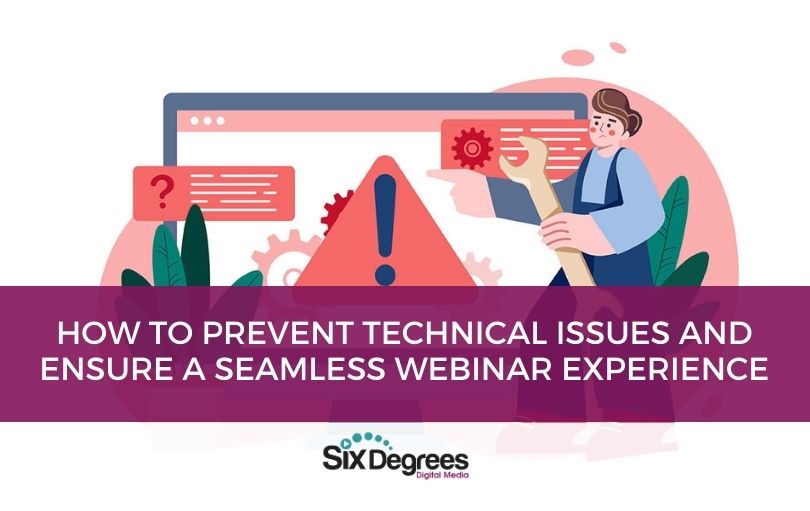Imagine the frustration attendees feel when faced with technical hiccups – lagging videos, unclear audio, or disruptions during crucial discussions.
Consider the pressure on hosts and their teams as they try to manage these unexpected issues in real-time. Without the right knowledge and guidance, these challenges can become overwhelming.
In this installment of our series on crafting the perfect webinar, we’re going over how to make sure the technical aspects of your webinar are set up for success and how to handle them quickly if something goes awry.
What Webinar Platform Should You Use?
Choosing the right webinar platform is crucial for ensuring a smooth and engaging virtual event. Zoom, GoToWebinar, and WebEx each bring unique offerings to the table, catering to various user needs and preferences.
Zoom is lauded for its simplicity, security, and reliability, providing a user-friendly platform that makes webinar setup straightforward and quick.
It offers a range of interactive features like polls, Q&A sessions, and webinar chat, alongside seamless integrations with third-party applications. Additionally, Zoom provides robust branding options, high-fidelity recordings, and the ability to host webinars up to 30 hours long, making it a versatile choice for various event formats.
On the other hand, GoToWebinar is known for its flexible scheduling options, offering one-time, series, or on-demand webinars.
It emphasizes audience interaction with tools like polls, surveys, and Q&A sessions, and automates email communications for efficiency. GoToWebinar also provides detailed analytics, integrations with various tools, and customizable branding, ensuring that hosts can create a tailored and insightful webinar experience.
WebEx brings to the forefront high-quality video and audio, alongside a suite of interactive features to keep participants engaged.
It is recognized for its strong security protocols and offers a specific solution, WebEx Events, designed for hosting larger online events and webinars. With customizable layouts, mobile access, and integrations with various workflows, WebEx provides a secure and flexible environment for virtual events.
Your choice might hinge on specific needs: if simplicity and ease of use are paramount, Zoom might be the way to go; for detailed analytics and scheduling flexibility, consider GoToWebinar; and for a secure platform with high-quality audio and video, WebEx could be your ideal choice. Assessing your specific webinar goals, audience size, and budget will guide your decision in selecting the platform that fits perfectly with your needs.
Technical Requirements: Audio, Video, Internet Speed
The clarity and reliability of your audio and video components are the bedrock of a successful webinar.
Audio Quality: Invest in a high-quality microphone that captures your voice with precision and eliminates background noise. Clear audio ensures that your message resonates clearly, keeping your attendees engaged without straining to understand your words.
Consider microphones with noise-canceling features, especially if you’re hosting from a busy environment. A headset microphone can also provide optimal sound quality, enhancing your voice’s crispness.
Video Quality: Choose a high-definition camera that captures sharp, vibrant visuals. Whether you opt for a webcam or a professional camera with streaming capabilities, ensure it can handle different lighting conditions.
Key Takeaway:
Adequate lighting is key; position yourself facing a natural light source or use soft, diffused artificial lighting to illuminate your face evenly, enhancing your visibility and creating a professional ambiance.
Internet Speed: Slow or unstable internet can lead to lags, pixelated video, or even disconnections, disrupting the flow of your presentation and frustrating your audience.
To gauge your internet speed, use online tools that measure both upload and download speeds. Aim for upload speeds of at least 3 Mbps for standard-definition video and at least 5 Mbps for high-definition video. If possible, connect to the internet via an Ethernet cable to ensure a more stable connection, especially if you’re hosting from a location with multiple users sharing the network.
Thorough Testing: Before the event, conduct comprehensive tests of your audio, video, and internet connection. Host mock webinars with your team to simulate the actual event conditions.
Test various scenarios, such as screen sharing, video playback, and interactive features, to ensure everything runs smoothly. These tests not only reveal potential technical issues but also provide valuable practice for you and your team, ensuring everyone is well-prepared to handle the webinar’s technical aspects.
Conducting Rehearsals and Handling Potential Issues:
Assemble your team for an exhaustive walkthrough, mirroring the flow of the actual event. During these rehearsals, focus on the nuances that make your webinar engaging and interactive.
Practice transitioning smoothly between slides, ensuring that each segue is seamless, capturing and retaining your audience’s attention. Simulate polls and interactive elements, rehearse conducting engaging Q&A sessions, and fine-tune the timing to maintain a steady pace.
Rehearsals aren’t just about content delivery; they’re about perfecting the rhythm of your webinar, synchronizing the efforts of your team, and refining the overall attendee experience.
Anticipating Potential Issues:
Identify potential stumbling blocks, whether they are technical glitches, attendee connectivity issues, or platform hiccups. Develop comprehensive contingency plans, empowering your team to pivot swiftly and seamlessly in the face of unforeseen challenges.
Prepare your technical support team to handle a spectrum of issues, from minor attendee concerns to more complex platform-related problems.
Key Takeaway:
By having well-thought-out contingency plans, you not only demonstrate your preparedness but also assure your attendees that their experience is a priority, even in the face of unexpected hurdles.
Dedicated Technical Support:
The heartbeat of any successful webinar lies in the presence of a dedicated technical support team, vigilant and ready to leap into action at a moment’s notice. As the event unfolds, their role becomes pivotal.
Their watchful eyes scan for any signs of attendee distress – be it connectivity woes or interface confusion – and their nimble fingers work swiftly to troubleshoot and resolve. Having a responsive technical support team ensures that your attendees feel cared for and supported.
Their presence provides a safety net, assuring both you and your audience that, no matter the challenge, a solution is just a click away.
Rehearsals not only refine your content delivery but also mold your team into a cohesive unit, poised to tackle any issue. Anticipating potential problems is your shield against the unpredictable, ensuring that your webinar sails smoothly even in choppy digital waters. Finally, a dedicated technical support team stands as your anchor, grounding your event in reliability and assurance, leaving both you and your attendees to focus on what truly matters: the content and the connection.
Ready to host flawless and engaging webinars without the stress? Schedule a free strategy session with Six Degrees Digital Media today. Our expert team will guide you through every step, ensuring your webinars leave a lasting impression. Don’t miss this opportunity – let’s make your next webinar an unforgettable success. Schedule your session now!










